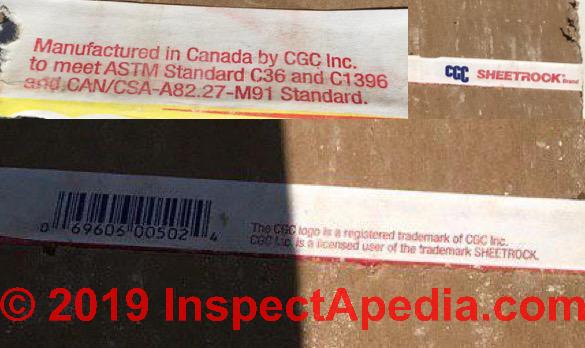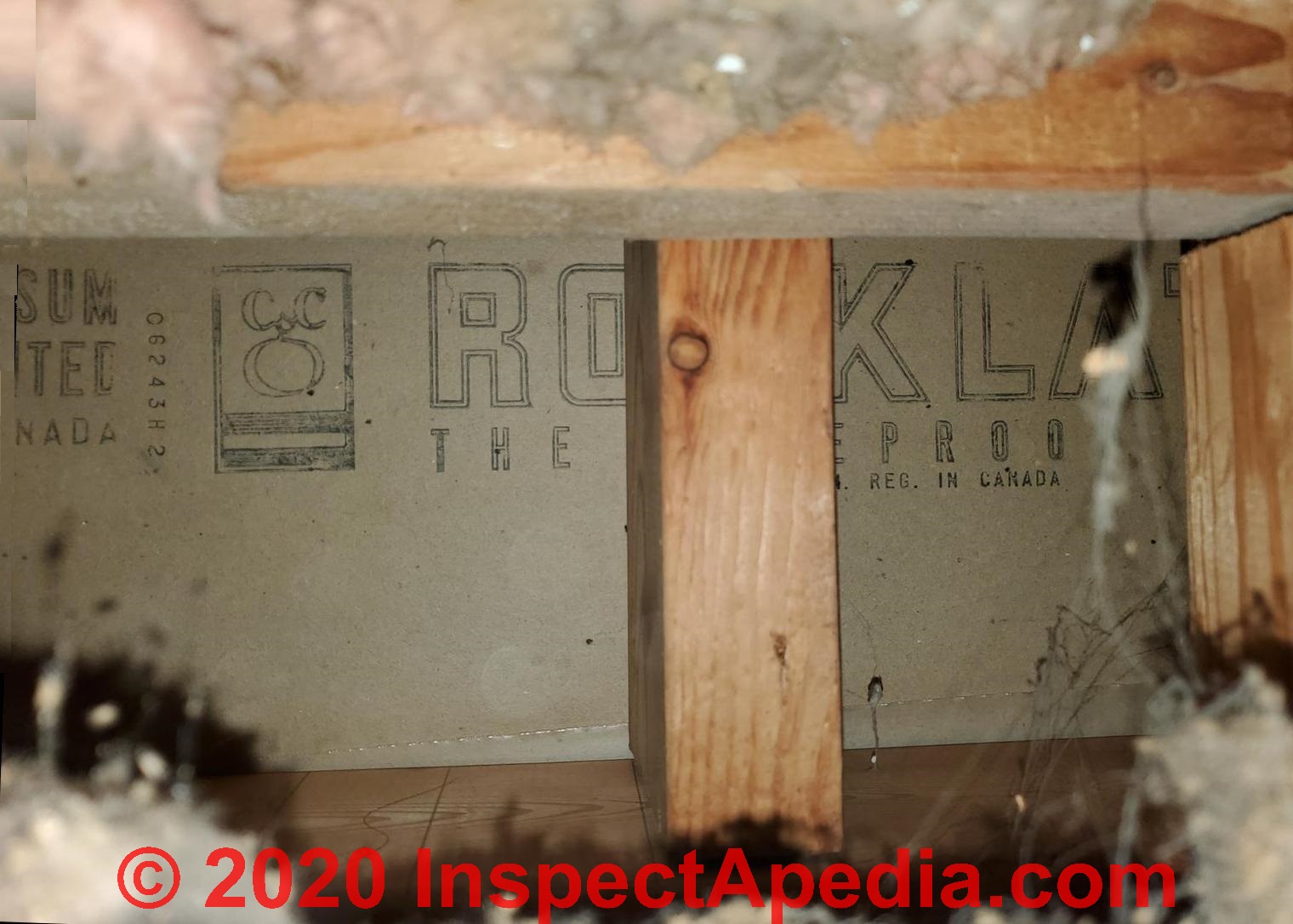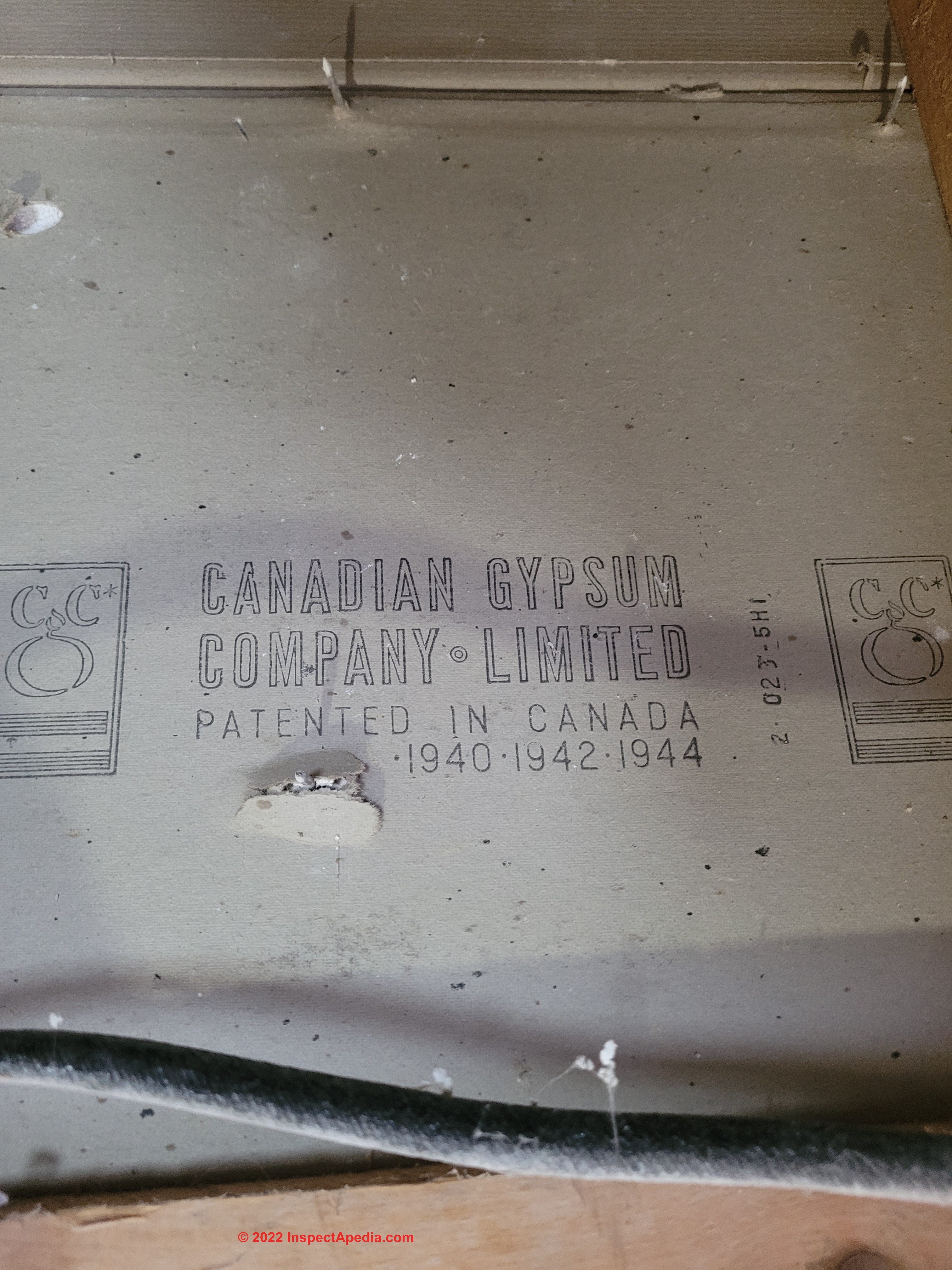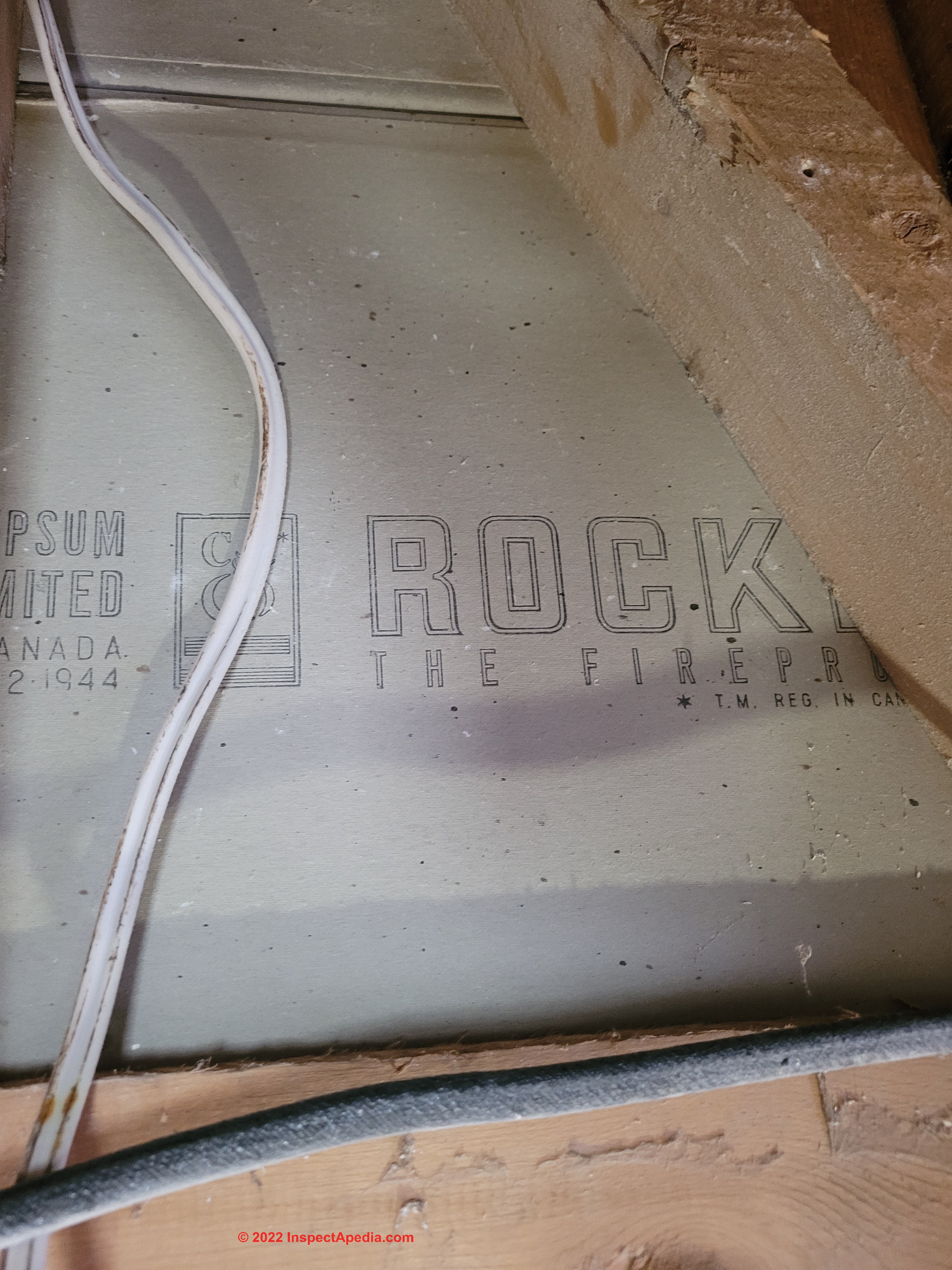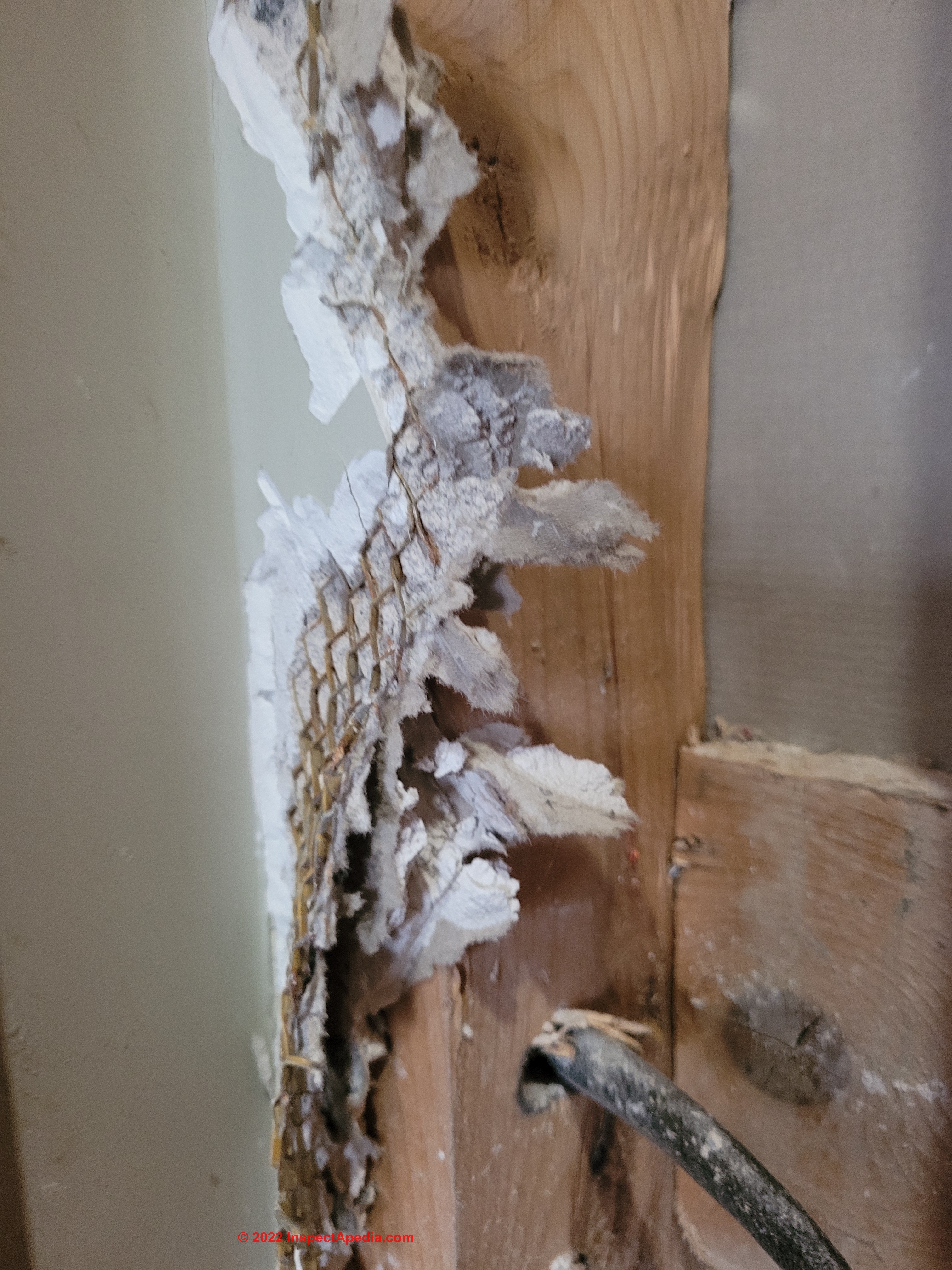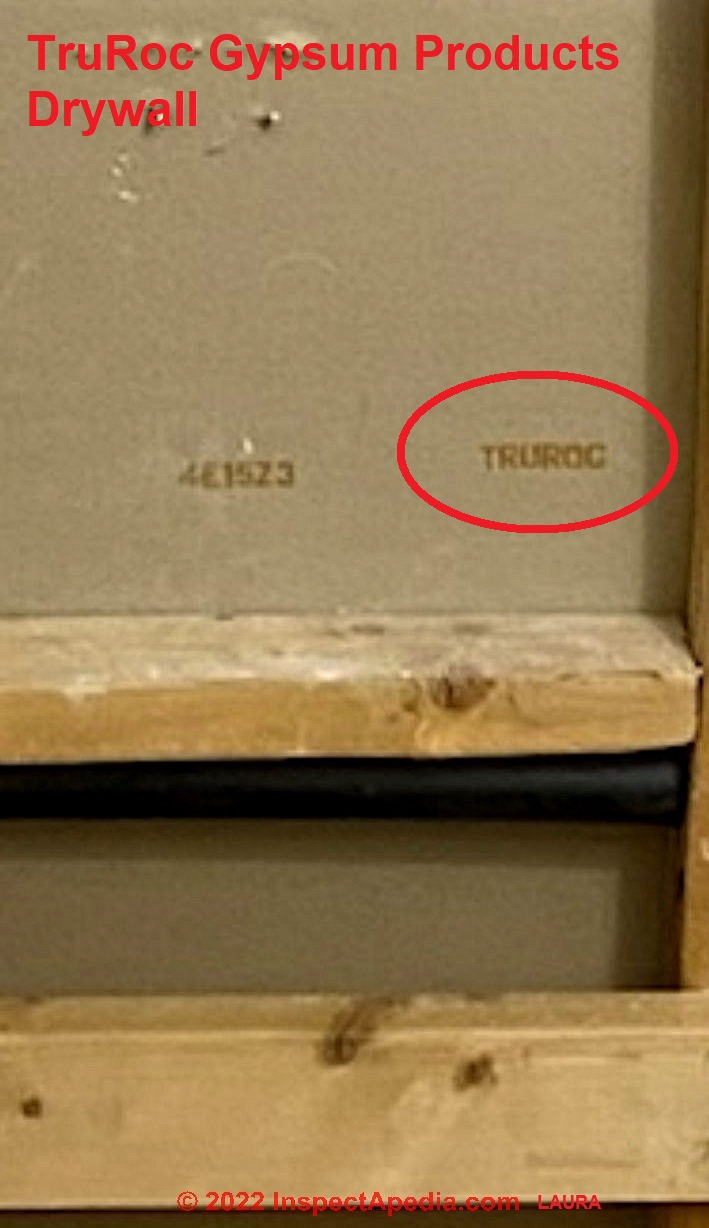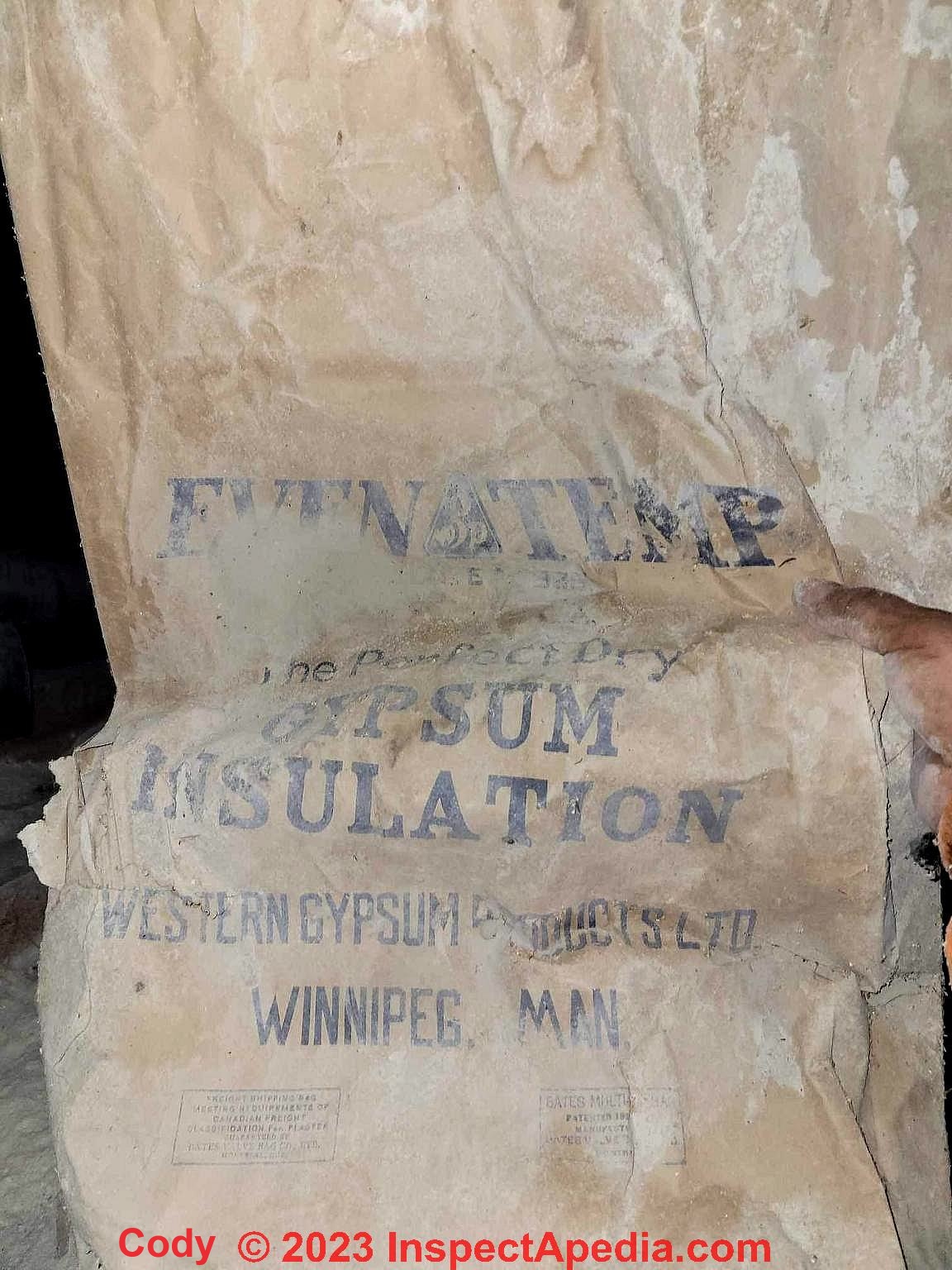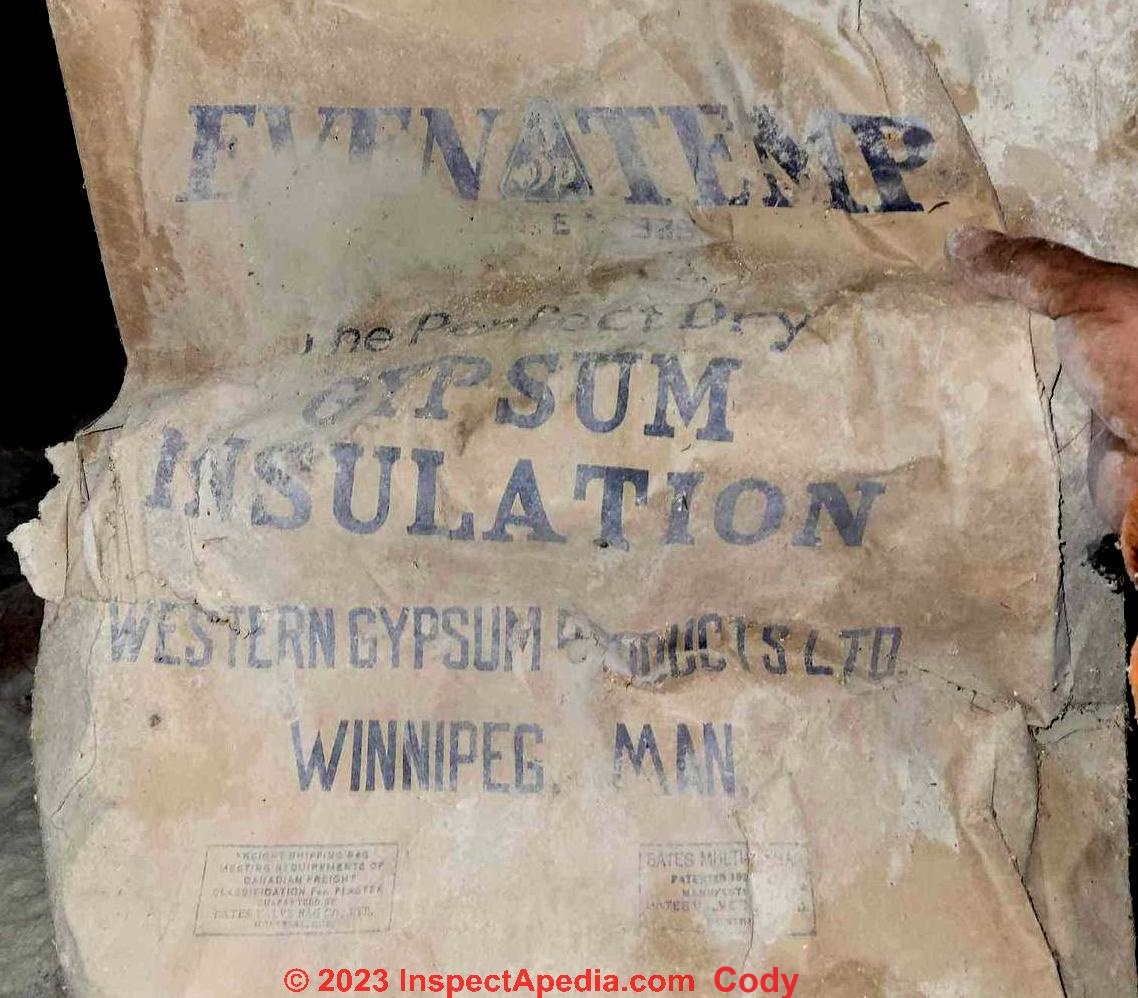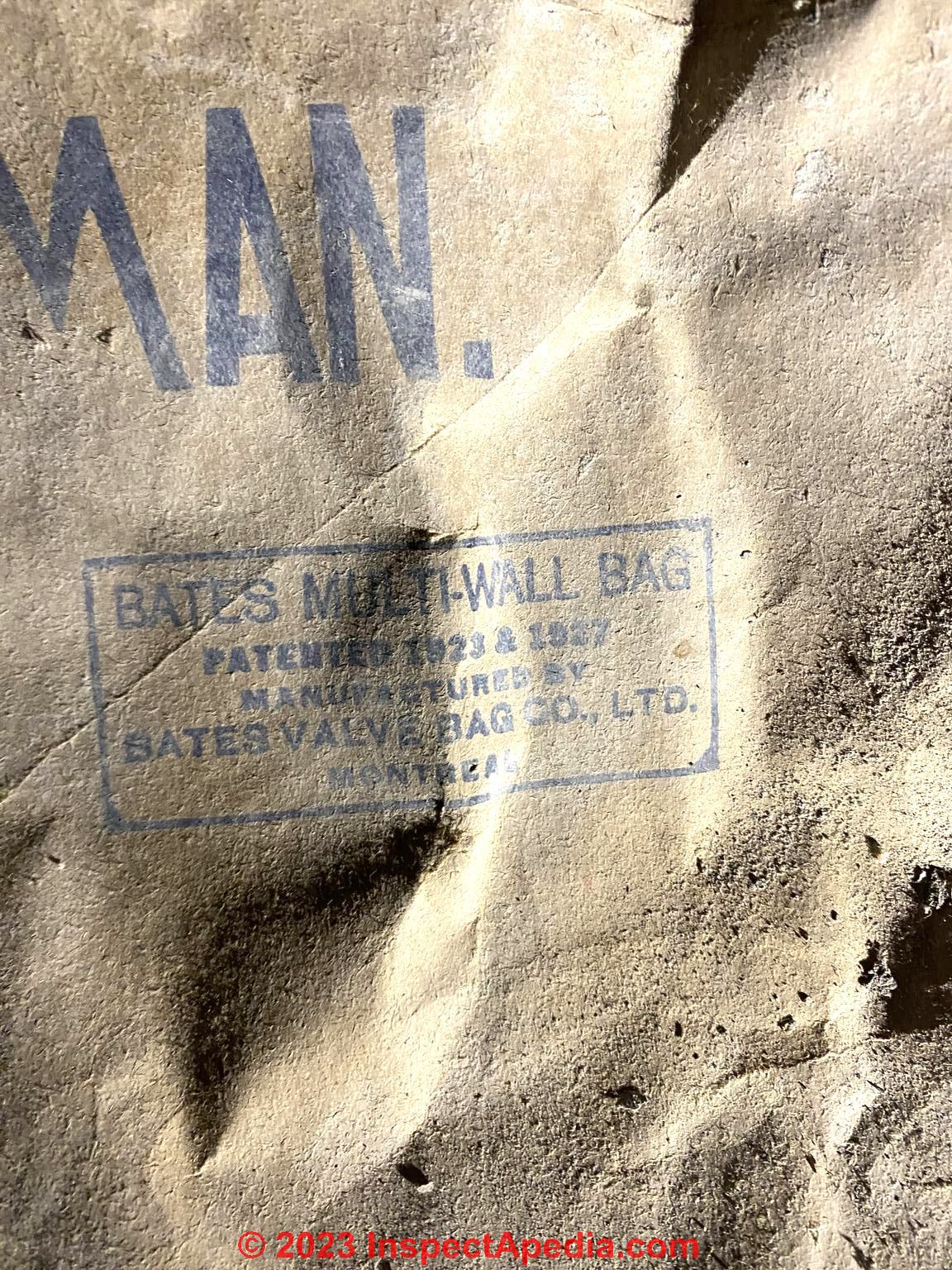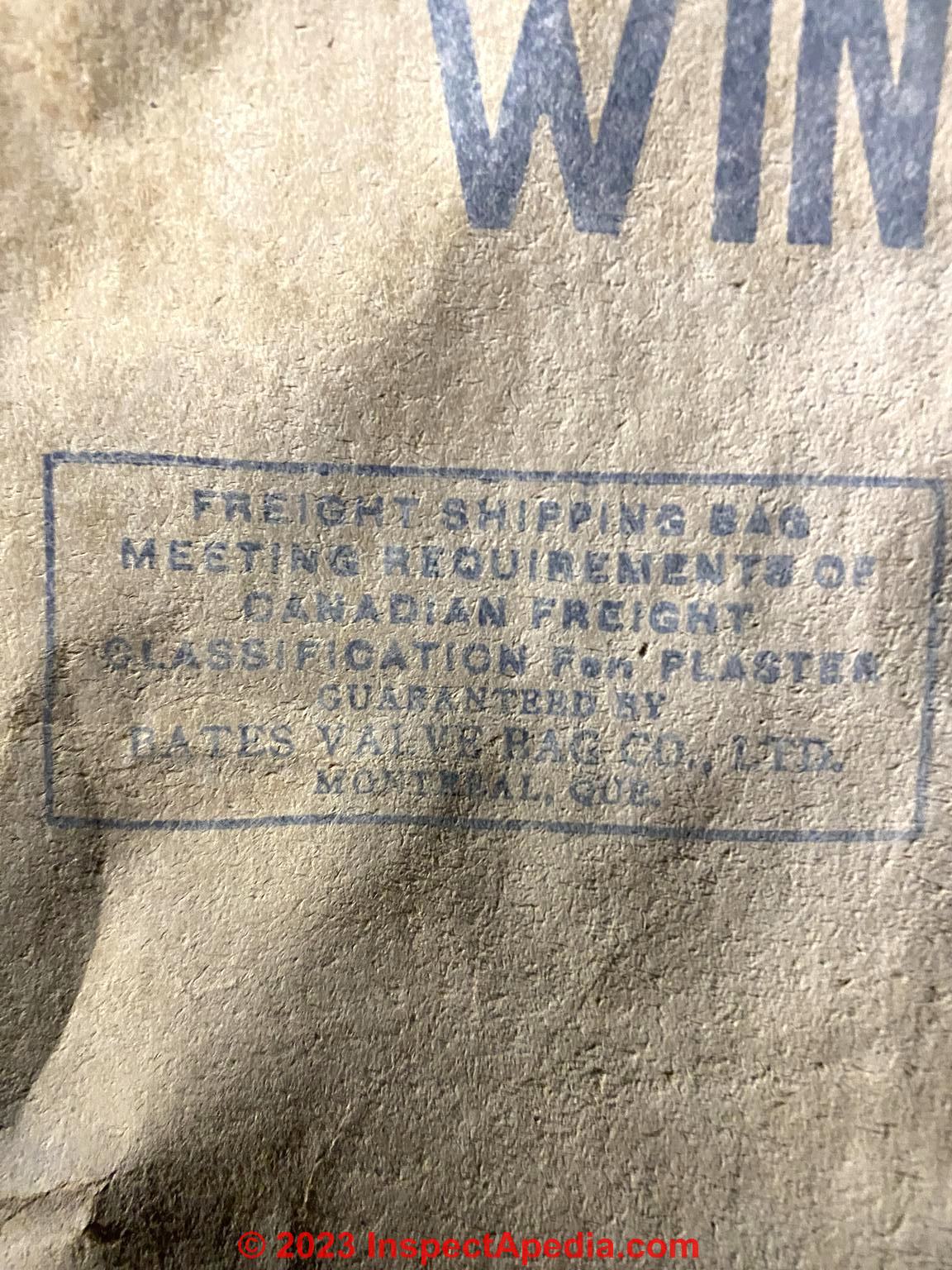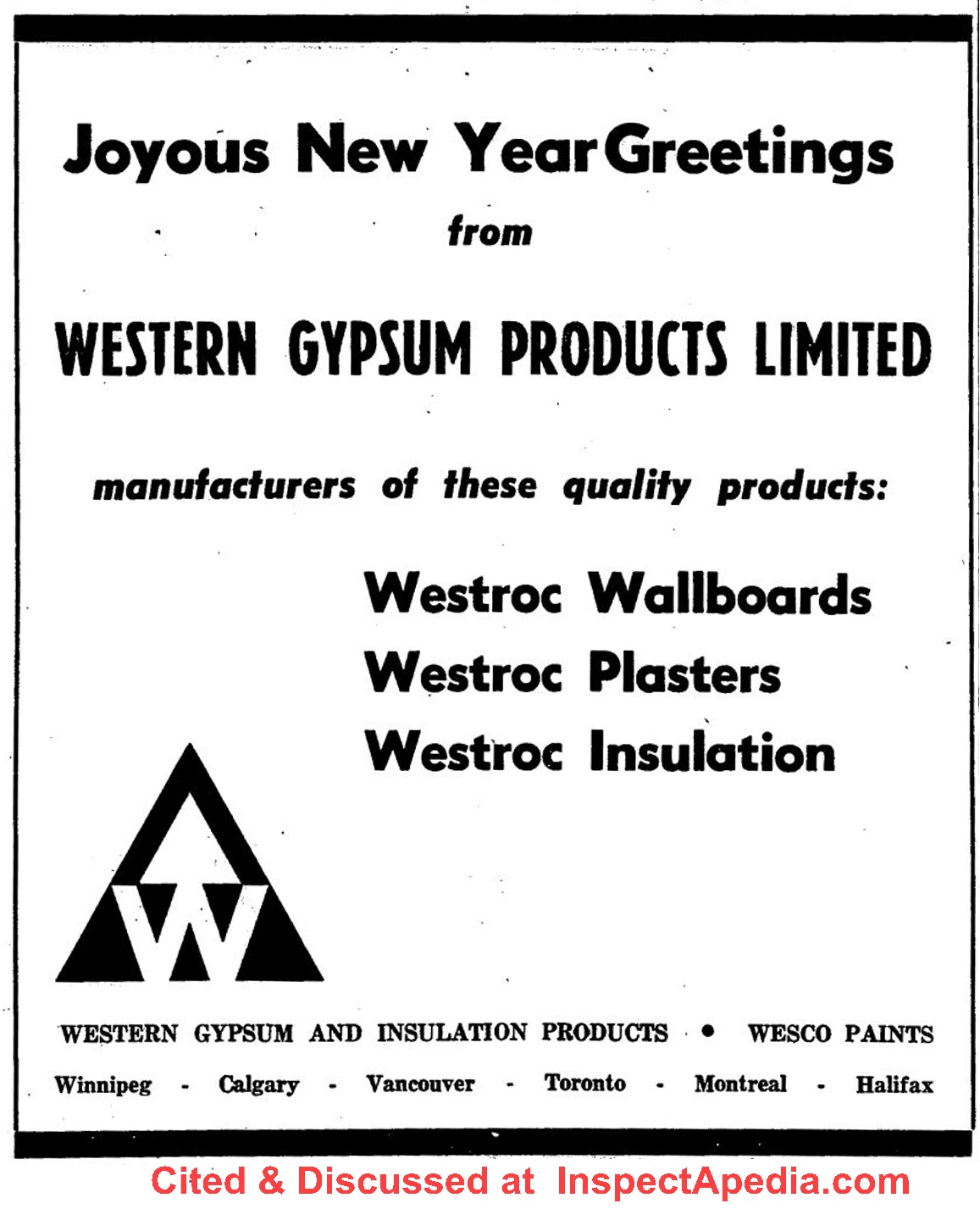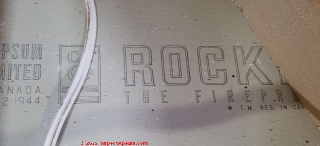 Asbestos Content in Canadian Drywall & Joint Compound
Asbestos Content in Canadian Drywall & Joint Compound
Canadian drywall products & finish systems that contain asbestos
- POST a QUESTION or COMMENT about the level of asbestos found in drywall on walls & ceilings.
Does Canadian drywall or "sheetrock" contain asbestos?
This article series explains where asbestos is likely to be found in gypsum board or drywall systems, particularly in the taping compound and in skim coats using drywall "mud" that contained asbestos.
InspectAPedia tolerates no conflicts of interest. We have no relationship with advertisers, products, or services discussed at this website.
- Daniel Friedman, Publisher/Editor/Author - See WHO ARE WE?
Asbestos content in Canadian Drywall, wallboard or "Sheetrock" or gypsum board & in joint compound
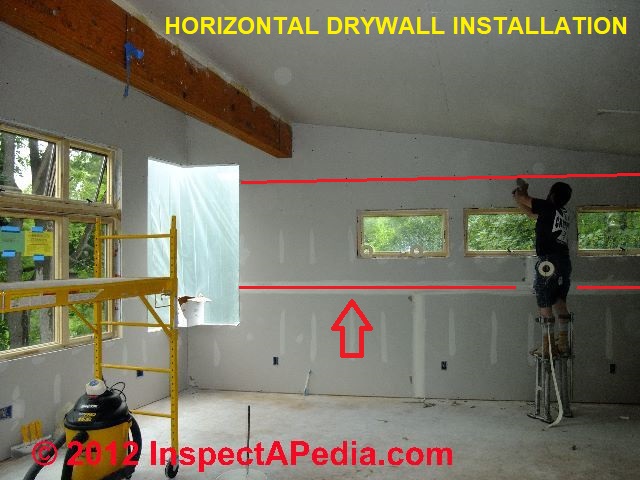 Drywall systems that may contain asbestos - at least in finishes, taping joint compounds, skim coats, or in systems that applied plaster over gypsum board date from about 1910 through the early 1980's in North America (1982 in Canada).
Drywall systems that may contain asbestos - at least in finishes, taping joint compounds, skim coats, or in systems that applied plaster over gypsum board date from about 1910 through the early 1980's in North America (1982 in Canada).
Taping drywall joints dates from as early as the 1920's. Asbestos-use in plaster overlaps this period.
In Canada most provinces classify the asbestos hazard associated with drywall removal as a "low risk or type 1" hazard requiring normal dust control. (Pinchin 2011).
Discussed in this article series: asbestos use in some (but not all) Canadian drywall products including:
- ASBESTOS in CANADIAN CGC DRYWALL? - USG-Canada Drywall & Rock Lath gypsum board
- ASBESTOS in CANADIAN GYPSUM COMPANY LIMITED FIREPROOF Gypsum Board
- ASBESTOS in CANADIAN DOMTAR GYPROC DRYWALL?
- ASBESTOS in CANADIAN GYPSUM LIME & ALABASTINE GLA DRYWALL - GYPROC
- ASBESTOS HAZARDS in CANADIAN TruRoc DRYWALL - RESEARCH
- ASBESTOS HAZARD RISK ASSESSMENT for CANADIAN DRYWALL
- ASBESTOS HAZARDS in CANADIAN DRYWALL - RESEARCH
- GENSTAR GYPSUM LTD ASBESTOS?
- IGNIFUGE GYPSUM BOARD ASBESTOS? - separate article
- WESTERN GYPSUM PRODUCTS LTD. ASBESTOS?
- WESTROC DRYWALL ASBESTOS? - see WESTROC DRYWALL / GYPSUM BOARD - on this separate page
[Click to enlarge any image]
Modern drywall and taping compound do not contain asbestos. However that was not always the case, as we detail here. If drywall or gypsum board or "Sheetrock®" was installed in your building in North America between the late 1920s and 1980 it is possible that the drywall or the joint compound used on the drywall contains asbestos.
Not all drywall sold during those years contains asbestos, and it's less commonly-found in residential applications.
Keep in mind that asbestos is not like a "radioactive" substance. It is not harmful if it is covered and /or otherwise left undisturbed. Avoid creating a dusty mess.
Excerpting from our master list of asbestos-containing products, ASBESTOS LIST of PRODUCTS we report the following example of evidence of the use of asbestos in drywall or gypsum board.
Principally you'll find that references to asbestos in a drywall system focus on asbestos that was contained in joint compound or in some paint or spray products such as "popcorn ceiling paint" that may have been sprayed on drywall ceilings.
Keep in mind that asbestos-containing joint compound may have been applied not only up to 18" wide over drywall joints but also in patches, repairs, around penetrations or fixtures, and in some buildings as a skim coat over an entire wall or ceiling surface.
...
Canadian CGC Drywall, Gypsum Board & Rock Lath
CGC - Canada Gypsum Co. - is a major manufacturer of gypsum board products as well as acoustic ceilings and other building materials produced & sold in Canada, forming a Canadian partner to USG - U.S. Gypsum.
The company has locations around the world. USG and probably CSG products known to contain asbestos were produced between about 1920 and 1978.
Contact: CGC Inc. Corporate Office 350 Burnhamthorpe Road West 5th Floor, Mississauga, Ontario L5B 3J1 Canada, Tel. (905) 803-5600 Toll free: 1-800-565-6607 Customer Service: Toll Free#: 1-800-387-2690 Website: https://www.usg.com/content/usgcom/en_CA_east/about-usg.html
Also see US GYPSUM DRYWALL IDENTIFICATION STAMPS identification.
Also see US GYPSUM SHEETROCK ASBESTOS
Also see USG 2" SOLID ROCKLATH & PLASTER PARTITION SPECIFICATIONS [PDF] - specifications & installation details from US Gypsum's 1952 Technical Specifications Book
CGC's parent company is United States Gypsum.
Question: Does this Canadian CGC Drywall contain asbestos
2018/0/29 Miti said:
Hi, thanks for your time and useful information. could you please check this photo and give me your opinion about the possibility of having asbestos contamination?
I have tried the manufacturer website, not much information.
We are remodeling our newly bought house, unfortunately, did not check for asbestos before starting the work, now frightened so much!
This is the drywall we have everywhere, I took photos of the info on it.
thanks so much!
Reply: no. But some older CGC drywall does contain asbestos.
Miti
As long as you're not making a dusty mess the fear is likely to be a greater health hazard than asbestos particles from undisturbed. material.
Keep in mind that asbestos was used in drywall compound, probably more-widely than in drywall. From our companion article
ASBESTOS PHOTO GUIDE to MATERIALS we excerpt:
Principally you'll find that references to asbestos in a drywall system focus on asbestos that was contained in joint compound or in some paint or spray products such as "popcorn ceiling paint" that may have been sprayed on drywall ceilings.
Keep in mind that asbestos-containing joint compound may have been applied not only up to 18" wide over drywall joints but also in patches, repairs, around penetrations or fixtures, and in some buildings as a skim coat over an entire wall or ceiling surface.
Drywall systems that may contain asbestos - at least in finishes, taping joint compounds, skim coats, or in systems that applied plaster over gypsum board date from about 1910 through the early 1980's in North America (1982 in Canada). Taping drywall joints dates from as early as the 1920's. Asbestos-use in plaster overlaps this period.
In Canada most provinces classify the asbestos hazard associated with drywall removal as a "low risk or type 1" hazard requiring normal dust control. (Pinchin 2011).
The U.S. advice for asbestos-containing drywall is provided by the US EPA and is given in the article we cited just above and in more detail
at ASBESTOS-DRYWALL REMEDIATION / REMOVAL
Question: was asbestos used in CGC Rock Lath gypsum board in the 1960s?
We have a home built in the early 1960's in Midland Ontario.
A currently paused bathroom reno revealed CGC Rock Lath board with the requisite plaster top-coat.
What are the chances that this has asbestos, and if so and based on percentages,
is a class 1 abatement by myself (full mask, throw away coveralls, etc.) a good plan? Images uploaded.
Aaron.
This Q&A on CGC Rock Lath asbestos were posted originally
Moderator reply:
Thanks for the photo and question, Aaron; we discuss the CGC rock lath asbestos question at ASBESTOS in CANADIAN CGC DRYWALL? - USG-Canada
at inspectapedia.com/hazmat/Asbestos-in-Canadian-Drywall.php#CGCDrywall (you are on that page)
where we state that "some older CGC drywall does contain asbestos."
In a 1960s Ontario home I'd treat the rock-lath as presumed to contain asbestos; If you can remove it without chopping, sawing, grinding, etc. to keep dust to a minimum you're minimizing your hazard; of course use dust control also to keep from blowing dust out of the bathroom into other house areas.
...
Asbestos in Canadian Gypsum Company Fireproof RockLath
Asbestos content in Canadian Gypsum drywall from 1940 - 1958 or later
Above and below: Drywall stamp by the Canadian Gypsum Company Limited (also later known as CGL), indicating patent dates of 1940, 1942, and 1944, found in a Canadian home. This drywall, where marked as "Fireproof" (shown below) should be treated as presumed to contain asbestos.
Question: does Canadian Gypsum Company Fireproof RockLath (Drywall) Contain Asbestos?
I saw comments on your website related to someone who was going to let you know of their Canadian Rock Lath from the 1950s tested positive for asbestos or not but I didn't see the result. Wondering if you might have any information about that?
We are currently renovating our home and now concerned if there is asbestos in the walls. - Anonymous by private email 2022/003/03
Moderator reply: treat Canadian Gypsum Company Limited Fireproof drywall as presumed to contain asbestos - test results are on this page
Yes, Anon, as you'll see below on this page, one of our readers had samples of Canadian Gypsum Company Limited Fireproof Rock-Lath drywall tested and confirmed the presence of Tremolite asbestos.
In general asbestos is not as likely to be found in OTHER drywall materials that were not required to have a fire-resistant rating, but it's still possible in both drywall, plaster, and joint compound. The last means that even if the drywall was asbestos-free your wall system may contain asbestos.
You'd be smart to treat the dust as presumed to contain asbestos or have representative samples tested.
Thanks for the question and photos - I will add your Canadian Gypsum Company drywall stamps to our online library. Our default is to keep you anonymous unless you want to be identified as a technical contributor.
Below we also include your photo of wire-lath based wall plaster from the same home.
See more about expanded metal lath plaster systems
and at PLASTER ASBESTOS CONTENT
2019/12/08 Anonymous asked by private email:
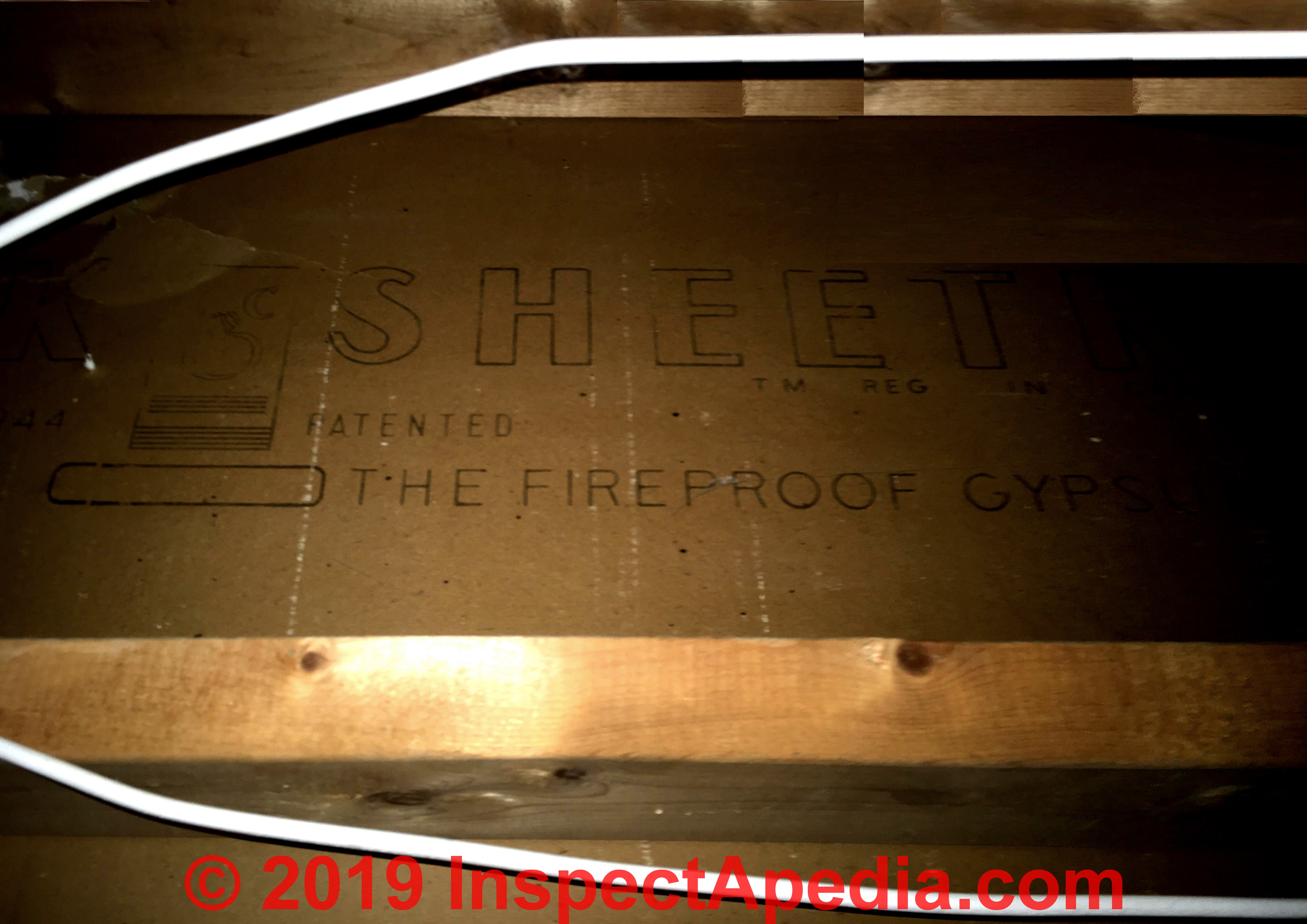 I've found sheetrock that says fireproof and patented 1944, made by Canadian Gypsum Company, some of them are pretty damaged, in the machine room,,, its cracked and pieces are sitting there with holes on gypsum.
I've found sheetrock that says fireproof and patented 1944, made by Canadian Gypsum Company, some of them are pretty damaged, in the machine room,,, its cracked and pieces are sitting there with holes on gypsum.
patent number is not printed on the board,
after going through your website I saw that fireproof gypsums contain asbestos and I am really concerned now.
Before bringing it to the test do you know if it indeed contains asbestos? if you can make comment on it it will be great,
Reply:
I cannot say for certain but some Canadian gypsum board from the 1940s indeed contained asbestos; if you proceed with testing (see ASBESTOS TESTING LAB LIST ) please let me know the result and show me the report as that would be very useful to other Canadian readers.
Try not to panic - that stress is probably a more-immediate health hazard than a section of drywall. As long as you're not grinding, sawing, chopping, etc. the amount of potential dust generated by just sitting there is close to or actually beneath the limits of detection.
Or to ease your mind just smear on some wide masking tape over any points of damage.
Reader follow-up:
I will inform you once I test it.
I am freaking out since its damaged and it is sitting in the furnace room(previous owner cracked it and left it there)
The house was built in 1954
Moderator reply: asbestos-containing drywall risk management: don't disturb, tape, wrap, encapsulate or - if you must remove:
Try not to panic - that stress is probably a more-immediate health hazard than a section of drywall. As long as you're not grinding, sawing, chopping, etc. the amount of potential dust generated by just sitting there is close to or actually beneath the limits of detection.
Or to ease your mind just smear on some wide masking tape over any points of damage.
See details at ASBESTOS-DRYWALL REMEDIATION / REMOVAL
Also see ASBESTOS HAZARDS in CANADIAN DRYWALL - RESEARCH
Reader follow-up:
I have cleaned up the dust with wet wipes and covered up the hole,, I guess that's all I can do for now,
Thanks again and I will inform once tested.
Question: Asbestos in 1958 Quebec home rock-lath or drywall?
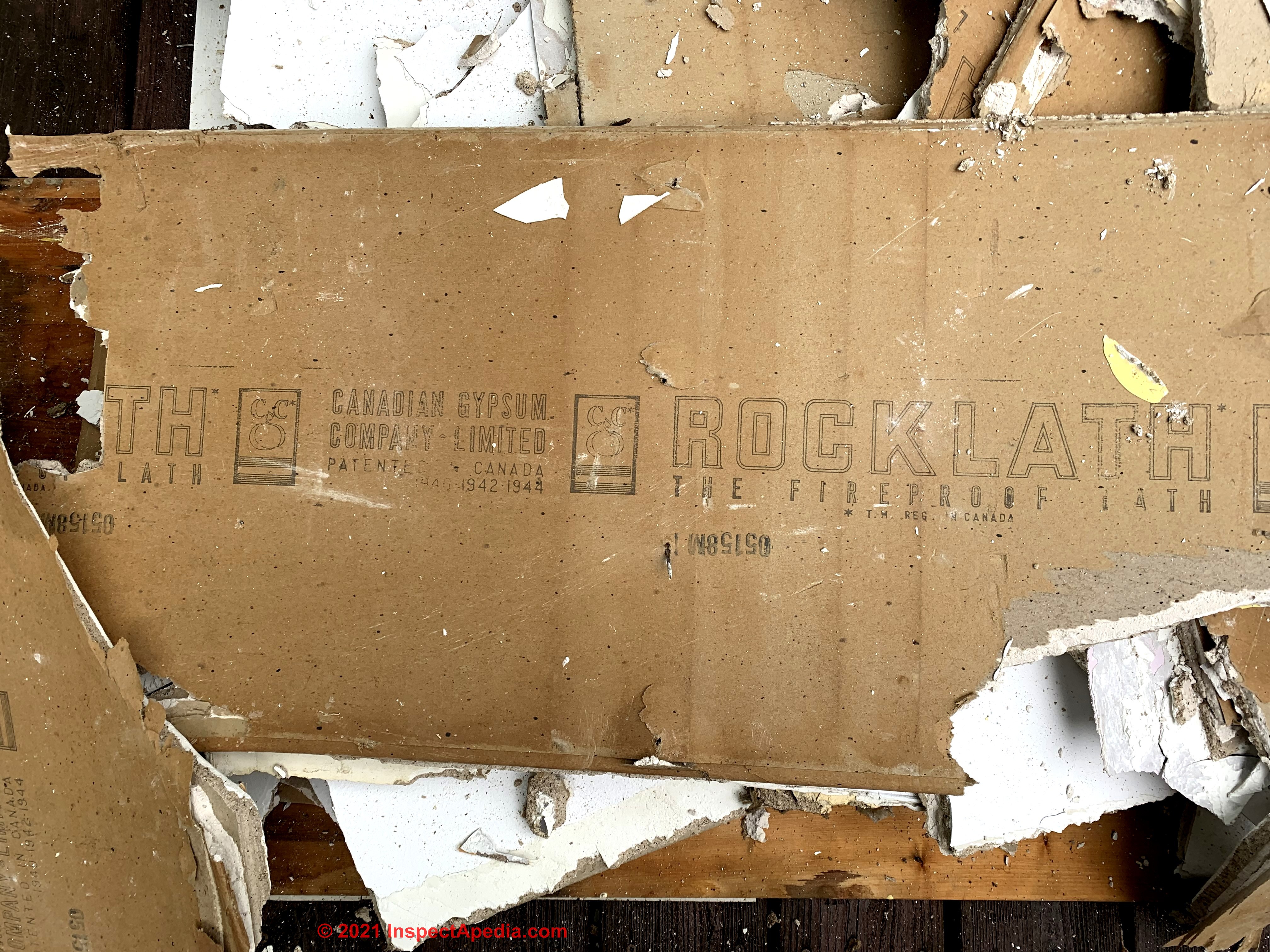 We bought a house made in 1958 in the province of Quebec and started to tear down walls in the kitchen and found boards made by “Canadian Gypsum Company Limited”. (See photos attached)
We bought a house made in 1958 in the province of Quebec and started to tear down walls in the kitchen and found boards made by “Canadian Gypsum Company Limited”. (See photos attached)
As soon as I realize that the product could be dangerous I stopped the “demolition project” and sent everyone out.
We’ve been exposed to dust for around two hours, there was a lot of cutting and smashing, and I’m really concern for the health of family members and “helpers” that were in the vicinity.
I saw on your website that it may contain asbestos and should be treated as so. Do you have more information on this product
I can’t find confirmation anywhere, and I can t believe, after all those years, that the information is not available.
I also know that all the walls of the house is made with this stuff! I saw it around the holes of electric and central vacuum outlets. There’s a lot of holes everywhere; cables, air ducts, wires, etc.
Should I have everything teared down by professionals or just the small project in the kitchen? - Anonymous by private email 2021/06/27
Moderator reply: 1950s plasterboard from Canadian Gypsum marked as "Fireproof"
1950s plasterboard from Canadian Gypsum that is marked as "Fireproof" is indeed a candidate to contain asbestos.
At this point you should
1. fight the panic as most-likely that's a worse health hazard
2. treat the plasterboard (this looks like "rock lath" - gypsum board used as a base for a plaster surface) as presumed to contain asbestos Or
3. have representative samples, perhaps of the dust from the board and a separate sample of the plaster, tested for asbestos
4. Use damp wiping and HEPA vacuuming to clean up
5. If there is extensive demolition needed for other reasons like renovation, don't proceed before answering the asbestos question, as "no asbestos" in the material means lower costs involved
6. Do not remove these walls or ceilings where not necessary for other reasons; those materials are safe and legal to leave in place as long as undamaged and undisturbed., even if they do contain some asbestos
7. At existing holes or cuts, you may want to spray-seal those edges to stop debris shedding: spray paint, shellac, or actual sealants sold for that purpose all are workable
Reader follow-up:
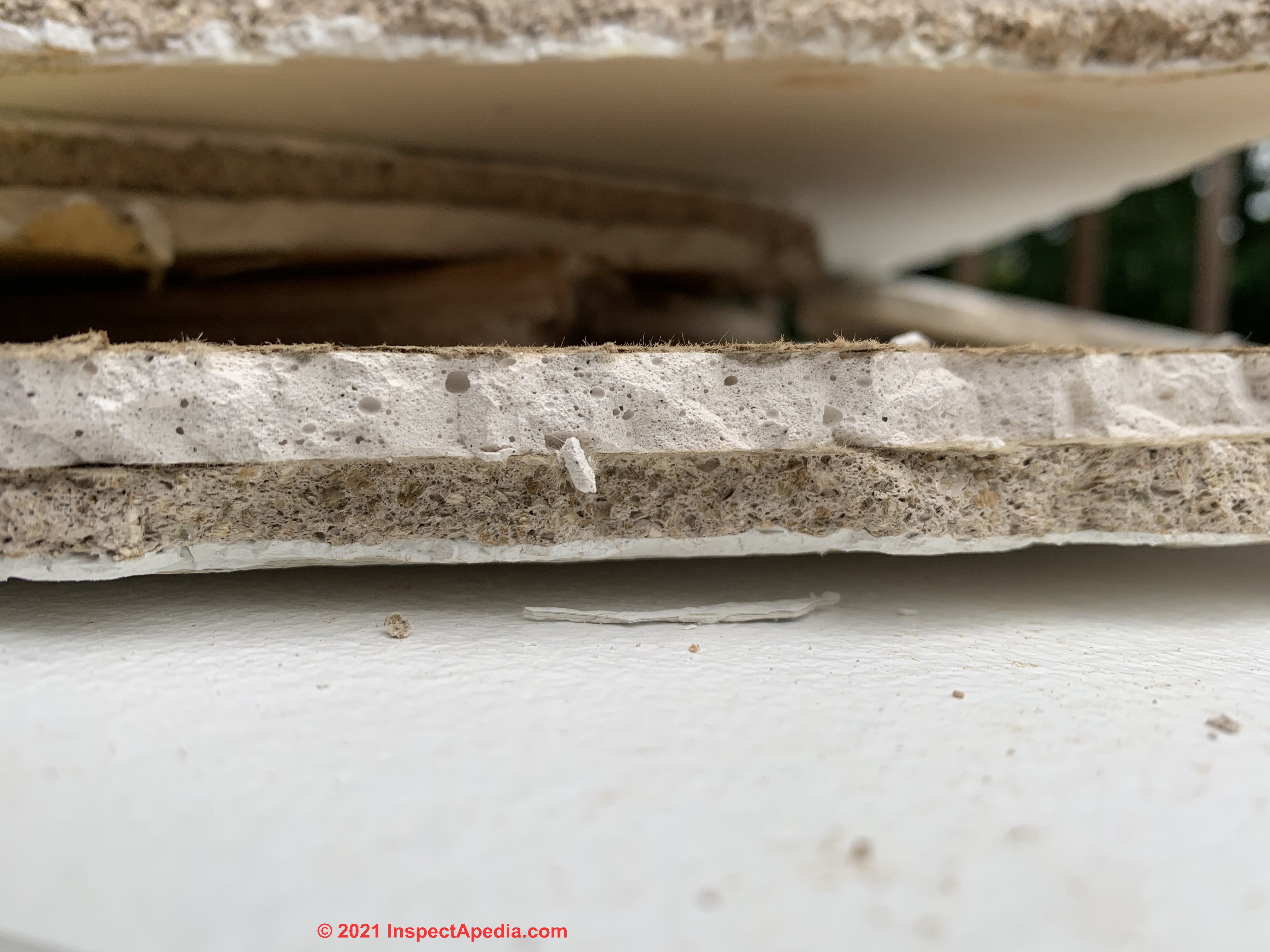 We left the construction site as is, all my tools are still there and I planned to have a sample analyse tomorrow. Won t go in there until I have the result. I also contact professionals in the field for removing the gypsum in all the rooms and cleaning all the house.
We left the construction site as is, all my tools are still there and I planned to have a sample analyse tomorrow. Won t go in there until I have the result. I also contact professionals in the field for removing the gypsum in all the rooms and cleaning all the house.
I prefer to be on the safe side and move in a clean home.
I have one question, I m not sure I understand your first point.
Are you saying I m overreacting to the possible danger (I would be totally fine with it, won t be offended at all, my wife told me I was ;-)
OR
you’ re saying “yep it’s really dangerous, but you can t do anything about it” OR that the panic is the danger here.
No right or wrong answer, just want to be sure I understand the point correctly.
Thanks again for the quick response and the information.
Moderator reply: bring health questions to your doctor; plaster dust is hazardous regardless of asbestos content
For any material "it's the dose that makes the poison."
Asbestosis occurs in some people who had chronic, prolonged exposure to high levels of airborne asbestos, such as shipyard workers in the 1940s who described the air as opaque with floating asbestos dust (Hills 1989), and it has occurred in some emergency workers exposed to extremely-high levels of airborne asbestos over a sort time, such as some of the emergency workers in New York City following the September 11 terrorist attack on the World Trade Center.
How hazardous might be a brief exposure to an unknown level of plaster dust that may contain asbestos?
What I meant to say is that we don't have a basis to know that what you have expose yourselves to is highly dangerous, but
Watch out: panic and fear of asbestos in a case like this one may be dangerous in any case to both your health and your wallet regardless of the asbestos level.
It's also the case that even if there is no asbestos in plaster dust, it still is bad for you to breathe it's a respiratory irritant and prolonged exposure for high enough exposure could certainly be a health hazard.
See PLASTER DUST EXPOSURE HEALTH HAZARDS
It's also my general approach, and only an opinion, that we can't do much about what's already happened and we can't completely assess its import without some lab work but what we can do is avoid further exposure.
Beyond what I said any further health questions really would need to start with your doctor. The actual risk of environmental hazards among people is enormously varied as are people's individual health and vulnerability.
Reader follow-up: Actinolite / Tremolite Asbestos confirmed in test results for Canadian Rock Lath
Here are the results of the test (in French). [Click to enlarge any image]
- The gypsum contain asbestos in the “beige layer”- Actinolite/Tremolite 1-5%.
Certified professionals are stripping the whole house since ALL the walls are cover with it. - Anon. by private email 14 July 2021
Hope it will help others to know what they might be dealing with.
Moderator reply: asbestos found in "sheetrock" from Canadian Gypsum Company 1944
Thank you very much for the update and of course I'm sorry that you find yourself faced with an expensive additional cleanup project.
Since you are going the route of extensive demolition make sure that the clearance inspection and tests are thorough and are by someone who is independent of the contractor who is performing the work.
As much as you can, try to manage down the worry and anxiety about this or at least discuss your concerns with your doctor to get some perspective, because I worry that the anxiety itself can become a health hazard in some cases greater than the environmental hazard.
On 2019-07-23 by Pascal
I just insulated my kneewall.. and I found out I had double drywall while making an entrance.. here a picture of the suspicious drywall in question..
Sheetrock from Canadian Gypsum Company 1944 .. it has the word Fire around it and has this serial number attached to the boards 15YWH. I already know the mud had asbestos.. what about the board itself?
...
Asbestos in Canadian TruRoc Drywall Gypsum Board
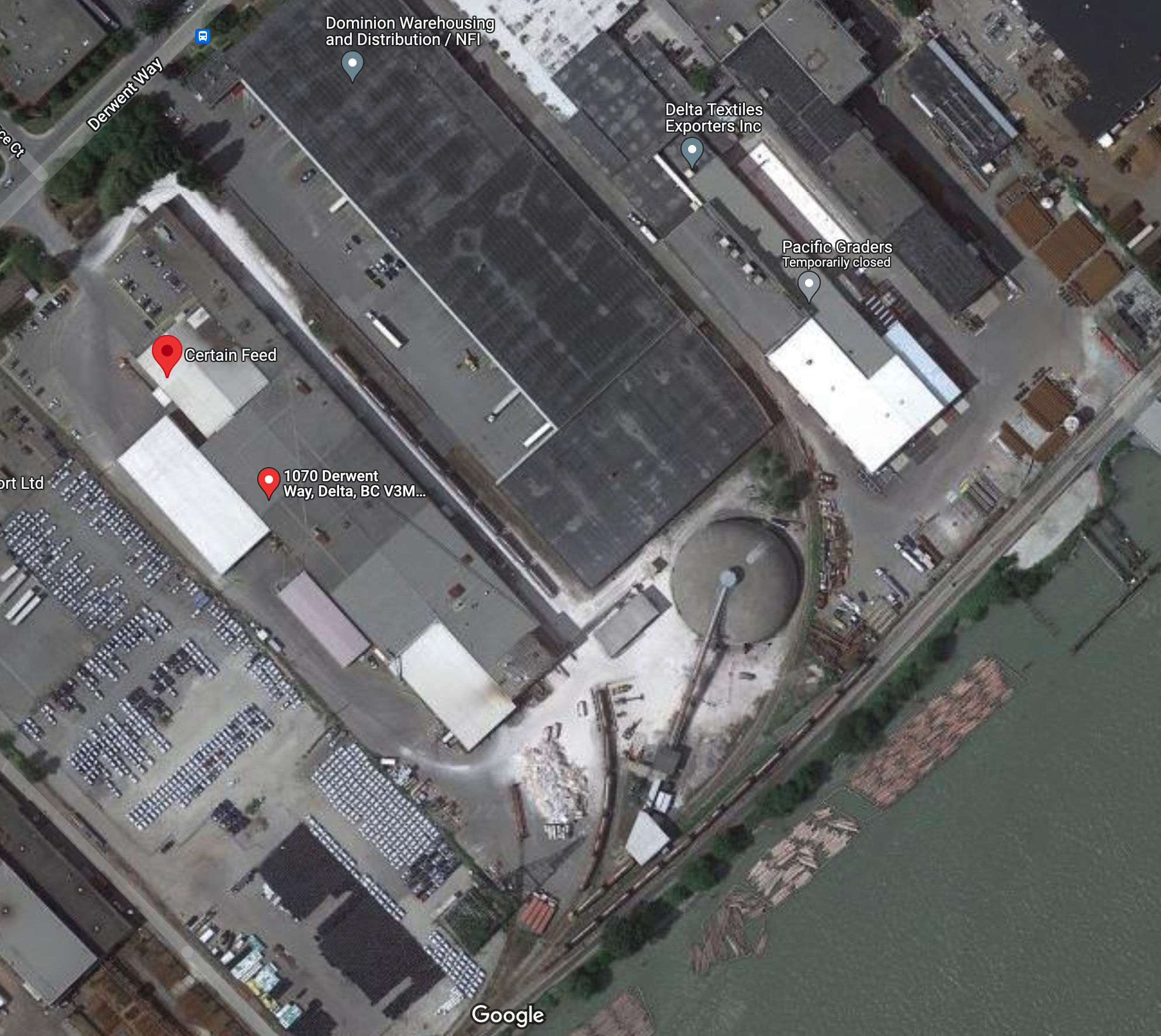 TruRoc is a Canadian brand drywall or gypsum wallboard product produced by TruRoc Gypsum Products, Ltd.
TruRoc is a Canadian brand drywall or gypsum wallboard product produced by TruRoc Gypsum Products, Ltd.
The TruRoc company, incorporated in Western Canada in 1970, was registered at 1500 Plessis Road, Winnipeg, MB R2C 2Z6 Canada.
By all of the corporate information sources we found (May 2022) the company's status is listed as Inactive - Amalgamated / Inactif - Fusionnée.
Indeed google maps shows that Plessis Road address today as a shopping mall containing Mucho Burrito and Pizza Hut restaurants.
Corporate information research sites assert that TruRoc is no longer an active Canadian corporation ( https://opencorporates.com/companies/ca/0288730 retrieved 2022/05/-4) , adding that
in 1978 TruRoc was amalgamated into Genstar Limited, a company that was itself incorporated on 31 March, 1978, originally registered at 1 Place Ville Marie Suite 4105 Montreal H3B 3R1 QC CA, but
note that Genstar is also an inactive amalgamated company dissolved in 1 January 1989. (https://opencorporates.com/companies/ca/0288217)
Research on TruRoc Drywall
Note: Canadian drywall made before 1990 may contain asbestos.
 Similarly, drywall sold in the U.S. before 1986 may contain asbestos.
Similarly, drywall sold in the U.S. before 1986 may contain asbestos.
We found older financial and other records in Canada from 1982 that describe the TruRoc company.
- (Government of Canada Gouvernement du Canada Receiver General for Canada Hon. Jean-Jacques Blais, MP., P.C. Public Accounts of Canada, Volume I, Summary Report and Financial Statements Canada - https://archive.org/stream/v1to3publicacc1982canauoft/v1to3publicacc1982canauoft_djvu.txt ) - retrieved 2022/04/04
- THIRD WORKSHOP ON RADON AND RADON DAUGHTERS IN URBAN COMMUNITIES ASSOCIATED WITH URANIUM MINING AND PROCESSING [PDF] ECB 1164-3 Sponsored by the Atomic Energy Control Board Under the Aegis of The Federal Provincial- Task Force on Radioactivity Port Hope, Ontario 12-14 March, 1980
p. 337, “Table of radon emanation rate from various drywall products” - retrieved 2022/05/04 original source: https://inis.iaea.org/collection/NCLCollectionStore/_Public/15/062/15062095.pdf - Page 25900 of the U.S. Federal Register lists a request filed by Double-B Trucking Co., Ltd. (a Surrey BC firm), to transport gypsum wallboard from Canada into the U.S. under contract with Truroc Gypsum Products., Ltd., of New Westminster, C, Canada,
giving the address for Truroc Gypsum Products , Ltd. 1070 Derwent Way, Delta, BC V3M 5R1, Canada - today (5/2022) an address of Certainteed Gypsum in Canada. (2022/05/04) - giving a hint into the succession of drywall companies.
Reader Q&A on TruRoc Drywall
On 2022-05-04 by Laura
Have drywall house built in 1970. Drywall stamped Truroc and then a postal code I am assuming…
On 2022-05-04 by Inspectapedia Com Moderator (mod)
@Laura,
thanks for the question and photo
TruRoc Drywall
TruRoc gypsum board was a Canadian drywall brand made in Western Canada.
Canadian drywall made before 1990 may contain asbestos.
Details are at ASBESTOS HAZARDS in CANADIAN TruRoc DRYWALL - RESEARCH
https://inspectapedia.com/hazmat/Asbestos-in-Canadian-Drywall.php#TruRoc
[you are now on that page ]
Where we will add your photo (do post a sharper image if you can - thanks in advance) and question, as that will be helpful to other readers and may invite further comment on the history of TruRoc Canadian drywall.
Bottom line: you should treat that TruRoc as presumed to contain asbestos - don't start a demolition job without first having it tested for asbestos (or treat it as presumed to contain asbestos).
If you decide to have your TruRoc tested for asbestos do let us know the result - that will benefit others.
See advice about managing the asbestos risk in older drywall at InspectApedia.com including
ASBESTOS-DRYWALL REMEDIATION / REMOVAL
also
ASBSTOS and GYPSUM DRYWALL PRE 1990 ADVICE VANCOUVER [PDF] retrieved 2022/05/04 original source: http://www.metrovancouver.org/services/solid-waste/SolidWastePublications/GypsumDrywallDisposal.pdf
at https://inspectapedia.com/hazmat/Asbestos-Gypsum-Drywall-Disposal-Vancouver.pdf
Excerpt:
Drywall installed pre-1990 may have asbestos. Until about 1990, the tape and joint compound, or ‘mud’, used to seal the seams and fill gaps between drywall boards sometimes contained asbestos. Asbestos-containing material is safe if left intact. When it is disturbed or damaged, asbestos fibres are released in the air.
When inhaled this may lead to asbestos-related diseases such as asbestosis and mesothelioma, which develop many years after the person has been exposed. Before renovating: Find out: Was the drywall in your home installed before or after 1990?
If after 1990, and you have documentation like a building permit and inspection report, then you can safely remove it.
If before 1990, have the drywall tape and joint compound tested for asbestos (this involves sampling by a qualified person and analysis by an accredited laboratory). If your drywall was installed before 1990, have it tested for asbestos.
On 2020-07-29 by D H - Truroc Gypsum Board ?
Does anyone know anything about ‘Truroc Gypsum’.
There are two visible numbers on the sections I am able to see.
7H28U7
7I06V8
It appears to be 1/2 inch and the house is of the age that there is likely asbestos.
Wondering what the fire rating on this gypsum would be (ie. wondering if half inch drywall with asbestos is more fire retardant that drywall with no asbestos).
...
Western Gypsum Products Ltd. Products & Asbestos
Western Gypsum Products Co. was founded in Winnipeg, Manitoba, in 1929. Western Gypsum produced Gypsum products from 1929 to 1963.
The Western Gypsum Products company headquarters was at 503 McArthur Bldg., Winnipeg, Manitoba, and the company's underground gypsum mine was at Amaranth with production facilities in Mayook, Winnipeg, and in Calgary Alberta (at least in 1949).
Westroc Industries Limited, the successor to Western Gypsum Products Limited, produced gypsum at the Silver Plains underground mine from 1964 to 1975, resulting from Western Gypsum Products Ltd. exploratory drilling that had been conducted there in the early 1960s. Production ceased at the Silver Plains gypsum mine after the mine flooded in 1975.
Western Gypsum also made exploratory drilling near Red River (near Aubigny) in 1976 but that did not lead to additional production.
In 1983 Westroc was operating the Drumbo gypsum mine in the Blenheim area. Westroc Industries Ltd., was acquired by British Plaster Board BPB back in 1954. BPB, incorporated in Britain in 1917, is currently a wholly-owned subsidiary of Satin Gobain and is the world's largest producer of drywall (aka wallboard or plasterboard).
For more about Westroc Industries see WESTROC DRYWALL / GYPSUM BOARD - also discussed
Presently (2023) CT Canada is the only gypsum products producer in Western Canada.
Question: Does Even Temp Gypsum Insulation (Powder) from Western Gypsum contain asbestos?
Hi, I have dry gypsum powder insulation in my attic.
The bags are marked as Even Temp Dry Gypsum insulation from Western Gypsum products. Would this contain Asbestos? Thanks! - Cody, 2023-11-26
Moderator reply: treat older powdered drywall or gypsum products as PACM
Thank you for the photo and the question, that's an interesting one and a brand that I don't know. I'll do some research and post a follow-up here. It would certainly be helpful to know the city where the building is located and the building age.
The product labeling in your photo reads:
Even Temp, the Perfect Dry Gypsum Insulation, Western Gypsum Products Ltd, Winnipeg Man - a Manitoba company.
As you'll read in this Canadian drywall asbestos article series, the 1989 Asbestos Act in Canada permitted use of existing stock of gypsum and drywall products so it's possible that homes built even into the early 1990s contained asbestos and certainly older gypsum and products like yours could contain asbestos.
To be clear, in Canada drywall, also called gypsum board or plasterboard, does not usually contain asbestos, though there are some exceptions, including among imported drywall products, but joint compound or similar powdered products might contain chrysotile asbestos.
Watch out: So it would be prudent to treat bags of unknown gypsum powder or joint compound powder as PACM or Presumed Asbestos Containing Material, OR if you are dealing with a large dusty mess of asbestos-suspect material, to have a sample tested by an AHERA certified inspector.
There are two small rectangles with additional data that, if you can smooth the paper and post sharp photos, will be useful for researching this question.
Also if you see any more writing on the packaging a photo of that that would be most helpful.
Sometimes for example you'll see a label that includes patent numbers.
Reader follow-up:
Here are 2 more pics, that is all for markings. A few of these bags were left empty on top of the loose powdered gypsum that is spread between every ceiling joist to a depth of 4-6 inches. I grabbed a sample for testing
Reader follow-up:
Thanks for the quick reply! Building is in Saskatchewan and is an old CN house. No idea on age but i’m told it’s built with old-growth fir. I would expect 1940s or earlier.
Couldn’t see a patent number on bag, I’ll take a better look this week and post again.
Patent was from 1929 and I also see “Gates Multi…”
Also a marking “Freight shipping bag meeting requirements of Canadian freight classification for plaster. Gates bag company Ltd.”
Moderator Reply:
Above: A Western Gypsum Products Ltd. advertisement that appeared in the Jewish Post, Vol XXXIX No 38, 19 Sept 1963 p. 33
Since we don't know whether that particular product contained asbestos or not and because it would be prudent to avoid breathing very fine dust particles of any material it would make sense to treat it with appropriate caution. Not something to panic about but it does deserve being careful.
For other readers: Western Gypsum Products Limited distributed Westrock wallboards, plasters and insulation as well as Wesco Paints, and distributed products across Canada including in Calgary, Halifax, Montreal, Vancouver and Winnipeg.
Until I have posted more information about EvenTemp plaster insulation from Western Gypsum, our best advice is at
ASBESTOS HAZARD RISK ASSESSMENT for CANADIAN DRYWALL
We'll follow-up here with more details about the company and its products and the asbestos question.
Research & History of Western Gypsum Products Ltd. & Westroc Industries Ltd.
- Dominion Bureau of Statistics, THE GYPSUM INDUSTRY 1949, Department of Trade and Commerce, Dominion Bureau of Statistics, Canada, retrieved 2023/11/27, original source: publications.gc.ca/collections/collection_2017/statcan/44-208/CS44-208-1949-eng.pdf, 1949 annual report on the mineral production of Canada. Prepared in the Mining, Metallurgical and Chemical Section, Industry and Merchandising Division, Donlinion Bureau of Statistics, Ottawa
Excerpt: Producers' shipments of gypsum during 1949 amounted to 3,014,249 tons valued at $5,423,90 compared with 3,216,800 tons valued at $5,548,245 in 1948. Output consisted of various grades of crude gypsum and crude anhydrite as shipped from quarries or mines, together with calcined gypsum used in or shipped from primary plants. Nine firms operated 14 quarries or mines in 1949. - Manitoba Energy & Mines, GYPSUM in MANITOBA [PDF] Manitoba Energy & Mines - retrieved 2023/11/27, original source: gov.mb.ca/iem/info/libmin/gypsum_in_manitoba.pdf
...
Diagnostic Questions on Risk of Asbestos in Canadian-Made Gypsum Board / Drywall or "Sheetrock®"
If you can establish the date of the home's construction that gives a floor under the "does my drywall contain asbestos" question - particularly when you add country and city of installation.
1. Check drywall back and edges for identifying stamps, dates, standards bar-codes.
Sometimes we get lucky in dating drywall from stamps and labels.
Your photo shows that the Canadian CGC drywall in your example complies with CAN/CSA A82.27-M91 - that is a standard published in 1991, (now withdrawn / replaced, Covers requirements for gypsum board designed for use with or without the addition of plaster, for walls and ceilings) so it's reasonable to infer that your drywall dates from 1991 or later.
ASTM Standard C36 Standard Specification for Gypsum Wallboard (Withdrawn 2005) was replaced by Active Standard ASTM C1396 / C1396M - but that doesn't give us an "earliest" date and had versions published in 1997 - 2003.
Similarly the sticker doesn't give an "earliest" date for ASTM C1396 / C1396M-17, Standard Specification for Gypsum Board, ASTM International, West Conshohocken, PA, 2017, www.astm.org
2. Location of drywall installation:
What are the country and city and date of construction of your home (presumably Canada)
3. Type of drywall installation:
Is the drywall installed in an area where fire-resistant drywall is likely to have been used such as in a boiler room or on a wall between a garage and occupied living space?
4. Age: date of drywall installation or dates of building:
When was the specific drywall installed? Was it from original construction or from a later renovation or addition?
5. Drywall manufacturer:
Even without finding stamps, stickers, or codes that help date a drywall or gypsum board product, if a stamp identifies the manufacturer (as most do) and if you know the ages or dates of the drywall you can often contact the company to ascertain if they ever used asbestos in their gypsum board products and if so during what years was that product manufactured.
Also see ASBESTOS PRODUCING COMPANIES & TRUSTS where we list companies known to have used asbestos in various products and where we give dates of that use.
...
Research on Asbestos Content in Canadian Drywall Products, Gypsum Board, Joint Compound, Drywall Mud, Textured Coatings
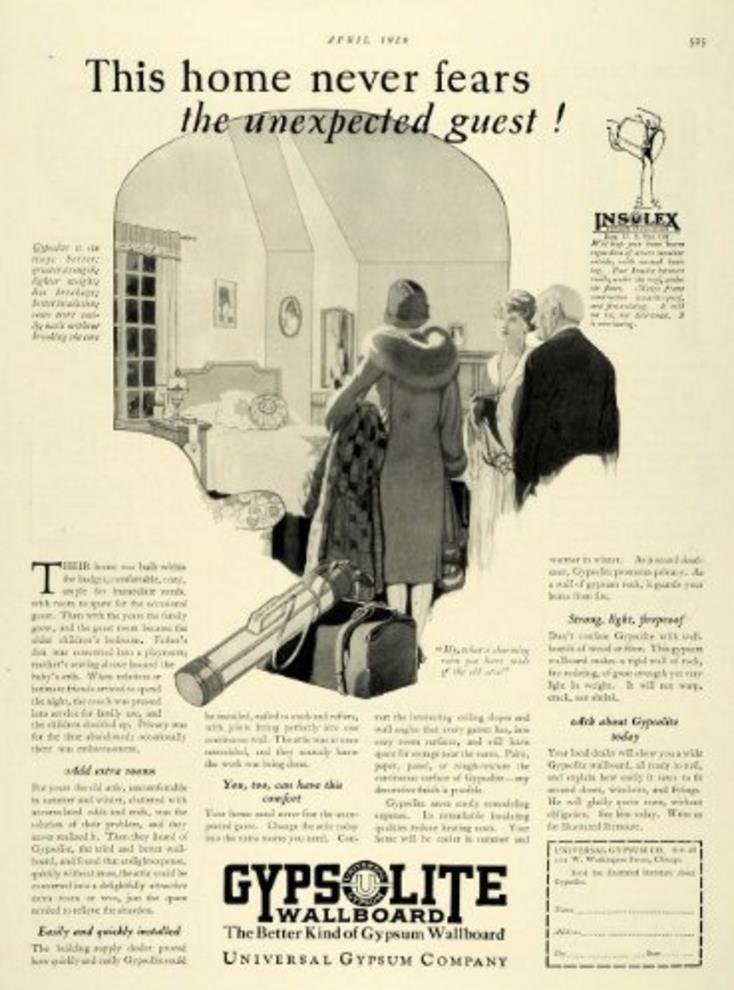 At above/left, a Gypsolite wallboard advertisement from 1926, placed by the Universal Gypsum Company, 111 W. Washington St., Chicago IL.
At above/left, a Gypsolite wallboard advertisement from 1926, placed by the Universal Gypsum Company, 111 W. Washington St., Chicago IL.
Some gypsum board or drywall products may have contained asbestos and asbestos was also commonly used in joint compound and other drywall or gypsum board coatings. Gypsolite, first mentioned in building products in 1888, is currently a registered trademark of National Gypsum.
[Click to enlarge any image]
Asbestos in Drywall or gypsum board products & asbestos content in drywall joint compound, drywall "mud", and textured coatings; includes Chrysotile asbestos, the most common form of asbestos found in products, especially in buildings (serpentine mineral with sheet or layered structure).
Question: is there an asbestos hazard in 1973 Domtar Construction Materials (DCM) Drywall?
2016/09/11, said:
KJohnson said:
I have a house built in 1973 that I had knocked out a piece of drywall not knowing that it may contain asbestos. The drywall was manufactured by Domtar Construction Materials Ltd (DCM Ltd) with a brand name "Gyproc" rather than gyprock.
It was also labeled as fireproof. This drywall has a bit of a pinkish hue and has some sparse but fine fibers sticking out of some of the cut edges. From what I understand, DCM Ltd was a Canadian division, but also had an American counterpart that used asbestos in its drywall mixture.
Would the Canadian drywall likely have used the same asbestos mixture, or could this have been made with fiberglass? I have been unable to find any manufacturing information on DCM Ltd.
The reader cites this study:
- HEALTH CONSULTATION, DOMTAR GYPSUM AMERICAN, INC. [PDF], , 801 Minaker Drive Antioch, Contra Costa County, California Epa Facility Id Cad089182810 May 7, 2008, U.S. Department Of Health And Human Services, Public Health Service, Agency For Toxic Substances And Disease Registry, Division Of Health Assessment And Consultation, Atlanta, Georgia 30333 Contact ATSDR 1-800-CDC-INFO http://www.atsdr.cdc.gov
The site of Domtar's Cornwall paper mill, first built in 1881 and sold to Paris Holdings in 2006, aka "the Big Ben Landfill And Recreation Area" receives demolition waste and "asbestos from the decommissioned mill". - Wikipedia retrieved 2020/01/04, original https://en.wikipedia.org/wiki/Domtar
This question was posted originally
Reply: Domtar, Antioch CA study did not find conclusive evidence of a high level of asbestos related illnesses / hazard
Mr. Johnson:
The study that you cite is of vermiculite including vermiculite processed at Domtar Gypsum American, Inc., in California. The word "drywall" does not appear in the study, but the words "Gypsum Wallboard" do. The study included sampling for worker exposure to asbestos at gypsum wallboard facilities. (op. cit. p. 6). Excerpt:
Exposure to dust that contained vermiculite (and asbestos) could occur when any clean-up tasks or tasks involving maintenance of equipment in dusty areas were conducted. Although clean-up and equipment maintenance processes were not observed, dry clean-up methods such as sweeping were reportedly used in the past (14). Dry sweeping would be expected to generate significant levels of dust into the air. - (op. cit. p. 6).
A read of this U.S. ATSDR drywall, vermiculite & asbestos exposure study suggests that the level of dust exposure of workers in the Domtar facility as well as possible dust exposure of their families to dust carried home on clothing, shoes, bodies of workers, would likely be enormously greater than dust exposure in an individual home by breaking away a single section of drywall
; further if that drywall were removed at its seams the dust from the drywall itself would have been minimal, and in my OPINION a greater dust exposure hazard would occur from the disturbance of drywall compound typically used at taped drywall butt joints.
Ingredients in drywall
Fiberglass, about which you inquired, is indeed an ingredient in drywall along with other dry ingredients including vermiculite (used in fire-resistant drywall products), perlite, starch, and sometimes sugar. These ingredients are mixed into calcined gypsum along with water to form a slurry that is spread over paper backing and then covered with paper and kiln dried.
History of Domtar Gypsum Drywall excerpting and adapting from the report cited above:
WR Grace and Company purchased the Libby Montana Zonolite vermiculite mine from the Zonolite Company in 1963.
Between the 1960s and 1980s, as much as 80% of the vermiculite used worldwide came from the WR Grace and Company mine near Libby. Libby vermiculite was shipped to over 200 locations in 30 states in the United States for processing or packaging.
Twenty of these facilities were located in California, including the Domtar Gypsum American, Inc., a gypsum wallboard manufacturing plant in Antioch, California.
From 1967 to 1978, this facility was called Kaiser Gypsum Company, Inc. Kaiser Gypsum was sold to Domtar, a Canadian company, in 1978 for $35 million. Domtar, the Canadian company was later sold to Georgia Pacific in 1996.
Since 1996, the current owner of the facility has been Georgia-Pacific Gypsum (G-P Gypsum). The current G-P Gypsum facility at the former Domtar site manufactures various building construction products, including gypsum wallboard.
With this corporate ownership history one cannot drywall made in or before 1973 was asbestos-free. However the actual risk involved in the case you describe sounds very small based on just your e-text which is, of course incomplete information.
Asbestos hazard from DOMTAR-branded Drywall - fire-resistant drywall contained Libby Vermiculite
More to the point, the study you cite is focused on asbestos hazards in vermiculite, an insulation material, processed at the site.
Between 1967 and 1984 at this site, Domtar used vermiculite to manufacture fireproof gypsum wallboard. This distinction is important. Unless your home's Domtar-branded drywall was a fireproof-rated version of drywall, it is not likely that your drywall contained asbestos-laden Libby-mined vermiculite.
It is important to note that at any facility where Libby vermiculite was processed and airborne dust levels were high, there could have been cross-contamination of some undetermined levels of asbestos and other products being manufactured, stored, or handled at the same facility even if those products were not intended to contain asbestos.
It seems likely, however, that the level of incidental asbestos in such non-asbestos products would be very small compared with the level of asbestos in products deliberately manufactured with Libby vermiculite that itself contained asbestos.
A review of the DEHS study that you cite combined with speculation about the reasonable chance that "knocking out" a piece of un-known-asbestos-content-drywall produced a significant risk of hazardous asbestos exposure for the building occupants suggests that unless you ran power tools or used similar methods that produced high levels of drywall dust, chances are the hazard concern you raise would have been below the limits of detection in the building.
Nevertheless good practice with any building demolition, dust, and debris would include use of damp wiping and HEPA vacuuming to clean up dust to minimize dust spread.
To know with more confidence what was in an unknown drywall sample I'd consider spending the (typical cost of) $50. to send a sample to a certified asbestos test lab. You can find such labs by searching InspectApedia for ASBESTOS TEST LABS.
2008 DEHS Asbestos hazard study at Domtar did not find evidence of significantly-higher rates of asbestos-caused cancers (lung cancer and mesothelioma) than the U.S. population
Here are excerpts from the study that you cite:
Foreword
Libby vermiculite was distributed to and processed by facilities located throughout the United States. Because human exposure to asbestos has possibly occurred in communities near these facilities, the Division of Health Studies of the federal Agency for Toxic Substances and Disease Registry (ATSDR) initiated a nationwide follow-up effort.
This project is designed to screen for similar impacts on the health of populations living near facilities that received shipments of Libby vermiculite.
As part of that effort, the Environmental Health Investigation Branch of the former California Department of Health Services, now California Department of Public Health (CDPH), received funding to conduct health statistics reviews on communities located near facilities that received Libby vermiculite.
This health consultation presents the results of the health statistics review for the population living near Domtar in Antioch, California.
Conclusions:
The cancer statistics review did not find any evidence that the census tract 3060.01 population
experienced statistically significantly higher incidence rates of asbestos-caused cancers (lung
cancer and mesothelioma) than the U.S. population during the years 1986-1995.
The SIR and
SRR results for the remaining cancers evaluated in this review indicate that an excess of
asbestos-related cancers in this Antioch population is not being obscured by physician
misdiagnosis.
...
Similarly, if exposure to asbestos can worsen the condition of pulmonary disease and lead to
premature death or higher disease fatality, then the SMR and SRR results for chronic obstructive
pulmonary disease are consistent with the hypothesis of community exposure to Libby asbestos.
However, SMR and SRR for other diseases of the respiratory system and for diseases of
pulmonary circulation did not show that asbestos exposure led to increased rates of these
diseases in the ZIP Code 94509 population compared to the U.S. population.
Cancers overall and selected outcomes assumed to have no causal relationship with asbestos
were reviewed for comparison. Results showed that the study and U.S. populations generally had
comparable incidence and mortality rates for reference cancers, with a slight deficit for incidence
of cancers overall. - Op. Cit. (2008)
- ASBESTOS ABATEMENT PRECAUTIONS [PDF] (2014) Parks Canada, Pt Pelee Concession Building Project No 30023823 retrieved 20178/04/23, original source https://buyandsell.gc.ca/cds/public/2014/02/21/ ecdd9979121582d545d91bedc9c108a8/02_82_10_-_ asbestos_abatement_type_1.pdf
- ASBESTOS REMOVAL GUIDE [PDF] IHSA Ontario, Canada, 5110 Creekbank Road, Suite 400 Mississauga, ON L4W 0A1 Canada Tel: 905-625-0100Tel: 1-800-263-5024 Health Safety Manual, retrieved 2018/04/23, original source: https://www.ihsa.ca/rtf/health_safety_manual/pdfs/hazards/Asbestos.pdf
- ASBESTOS PRODUCING COMPANIES & TRUSTS - complete list includes all asbestos-containing drywall producing companies
- Health Canada:
Excerpt:
... To minimize risk of inhaling airborne asbestos, homeowners should receive expert advice before removing any materials that may contain asbestos removing any materials that may contain asbestos.
... If handling small amounts of damaged asbestos-containing materials, homeowners should follow a series of steps including sealing off the work area, wetting the material, avoiding cutting, breaking or damaging the material, wearing protective clothing including a single-use respirator, sealing the waste in plastic bags, and disposing of the waste according to municipal regulations. - HEALTH CONSULTATION, DOMTAR GYPSUM AMERICAN, INC. [PDF], 801 Minaker Drive Antioch, Contra Costa County, California Epa Facility Id Cad089182810 May 7, 2008, U.S. Department Of Health And Human Services, Public Health Service, Agency For Toxic Substances And Disease Registry, Division Of Health Assessment And Consultation, Atlanta, Georgia 30333 Contact ATSDR 1-800-CDC-INFO http://www.atsdr.cdc.gov
- Henkel, William W. "Method of plastering wall surfaces and joint sealing compound used therein." U.S. Patent 3,382,119, issued May 7, 1968. Original assignee: Valspar Corporation, a North American manufacturer of paints & coatings since 1806.
Excerpt: The joint compound was made up in a quantity of 2500 /2 lbs. as follows (dry basis): 2100 lbs. No. 3 Whiting calcium carbonate obtained from Thomson Weinman & Co., 180 lbs. Mineralite M260 mica from Mineralite Sales Corp, 98 lbs. of #7RF-l0 asbestos from Carey- Canadian Mines Ltd. and 25 lbs. of Mistron Monomix Talc from Sierra Talc Co., were mixed to provide the filler. 57 lbs.
Gelva Powder 702 (polyvinyl acetate) from Shawinigan Resin Corp, and 19 lbs. #2030 BP (polyvinyl alcohol) from Shawinigan were mixed to provide the binder. The adjuvant included 14 lbs. of #4000 HG- 65 Methocel obtained from Dow Chemical Co., and 5% lbs. potassium tripolyphosphate from Kraft Chemical and 1% lbs. anhydrous sodium acetate was obtained from Kraft Chemical Co. ...
I find that to achieve the advantageous integration of the joint cement with the gypsum panels, the characteristic of the filler should follow that of the optimum formulation set forth above, particularly relative to mica and asbestos.
This is helpful not only in the plastering procedure set forth in the above example, but, also in the dry wall operation where crackless joints are mandatory. For the asbestos, I find the fiber should be of such a length (dry) as to have slightly under 50% retained on a 35 mesh Tyler sieve.
The actual distribution of asbestos fibers in this drywall product was as given in Table I below:
Table I Mesh size Percentage retained 14 Trace 28 2.0 35 40.0 100 35.0 200 1.5 Pan 16.5
The bulk density of the asbestos fibers was about 10.5 lbs. per cubic foot and the wet volume (settling rate for fibers of a given weight and a given quantity of water) was two hours for 10 grams in 500 cc. of water and four hours for 50 grams in 2000 cc. of water.
The absorbability of the asbestos was determined in a number of ways to characterize the optimum formulation. - Hills, B. (1989) Blue Murder: Two Thousand Doomed to Die – The Shocking Truth
About Wittenoom’s Deadly Dust, South Melbourne, Sun Books.
… in the mill it [level of airborne asbestos dust] was blinding. One hundred-watt light bulbs hanging from the ceiling of the tin shed looked like candles, one worker recalls.
When you walked in, you had to get within a couple of feet of a man to recognise him, because their faces were coated with dust like pancake make-up. - IGNIFUGE GYPSUM BOARD ASBESTOS? - older products including Canadian Ignifuge-rated drywall contain asbestos
- Nowick, Chester R., and DeFranza, Alfred, U.S.A., METHOD of DRYING GYPSUM WALLBOARD and APPARATUS THEREFOR, Canadian Patent No. 1095233, Issued 810210, granted to National Gypsum Company, U.S.A.
- Pinchin, Don, "A Canadian Perspective on Asbestos Precautions for the Removal of Drywall with Asbestos-Containing Drywall Joint Compound (ACDJC)", [Presentation] (2011), Pinchin Environmental, Website: www.pinchin.com, Tel: 1-855-PINCHIN, retrieved 2015/12/11, original source: http://www.chba.ca/uploads/CRC/May%202011/Asbestos%20Presentation%20-%20May%202011.pdf
- Santmyers, R.M., THE CANADIAN GYPSUM INDUSTRY, [PDF] Information Circular, Department of Commerce, Bureau of Mines, Circular NO. 6162, August 1929, retrieved 2019/01/04, original source: https://digital.library.unt.edu/ark:/67531/metadc784355/m2/1/high_res_d/metadc784355.pdf
Possibly significantly, the word "asbestos" does not appear in this document. - Verma DK, Middleton CG. Occupational exposure to asbestos in the drywall taping process. The American Industrial Hygiene Association Journal. 1980 Apr 1;41(4):264-9.
Abstract
Studies of airborne asbestos fiber concentrations associated with various operations of the drywall taping process have been undertaken in the province of Alberta, Canada.
The results show that mixing, sanding and sweeping created high levels of airborne asbestos dust. The measured concentrations were frequently in excess of occupational health standards.
Sanding in particular was assessed the most hazardous operation. The results are discussed in light of present and proposed Occupational Health Standards, and in terms of its implications for other workers, household contacts, and consumer's risk. Measures to reduce and control the health hazards associated with the process are described.
Canada Domtar Corporation Gyproc Drywall Asbestos - Gyproc
This topic has moved to ASBESTOS in CANADIAN DOMTAR GYPROC DRYWALL? - GYPROC
GLA: Canada Gypsum Lime & Alabastine Limited Gyproc Fireproof Wallboard
This topic has moved to ASBESTOS in CANADIAN GYPSUM LIME & ALABASTINE GLA DRYWALL - GYPROC
...
...
Continue reading at ASBESTOS-DRYWALL REMEDIATION / REMOVAL or select a topic from the closely-related articles below, or see the complete ARTICLE INDEX.
Or see ASBESTOS in CANADIAN DRYWALL FAQs - questions & answers posted originally on this page
Or see these
Recommended Articles
- ASBESTOS in DRYWALL - home
- BESTWALL DRYWALL ASBESTOS
- CANADIAN DRYWALL ASBESTOS
- CANADIAN GYPSUM LIME & ALABASTINE GLA DRYWALL ASBESTOS?
- CELOTEX DRYWALL ASBESTOS
- CERTAINTEED DRYWALL ASBESTOS
- DOMTAR GYPROC ASBESTOS?
- GENSTAR GYPSUM LTD ASBESTOS?
- GYPSUM BOARD GYP ROCK SHEATHING
- IGNIFUGE GYPSUM BOARD ASBESTOS?
- NATIONAL GYPSUM DRYWALL ASBESTOS?
- PICTURE HANGING NAILS to avoid damage/dust
- PLASTER TYPES & METHODS in BUILDINGS
- US GYPSUM SHEETROCK ASBESTOS
- SHEATHING, GYPSUM BOARD
- ASBESTOS-DRYWALL REMEDIATION / REMOVAL
- ASBESTOS in PLASTER - rock lath systems may contain asbestos
- CANADA ASBESTOS REGULATIONS
- DRYWALL & GYPSUM BOARD COMPOSITION & HISTORY - home
- DRYWALL MANUFACTURER IDENTIFICATION STAMPS & DATE CODES
- DRYWALL TYPE IDENTIFICATION STAMPS
Suggested citation for this web page
ASBESTOS in CANADIAN DRYWALL at InspectApedia.com - online encyclopedia of building & environmental inspection, testing, diagnosis, repair, & problem prevention advice.
Or see this
INDEX to RELATED ARTICLES: ARTICLE INDEX to ASBESTOS HAZARDS
Or use the SEARCH BOX found below to Ask a Question or Search InspectApedia
Ask a Question or Search InspectApedia
Try the search box just below, or if you prefer, post a question or comment in the Comments box below and we will respond promptly.
Search the InspectApedia website
Note: appearance of your Comment below may be delayed: if your comment contains an image, photograph, web link, or text that looks to the software as if it might be a web link, your posting will appear after it has been approved by a moderator. Apologies for the delay.
Only one image can be added per comment but you can post as many comments, and therefore images, as you like.
You will not receive a notification when a response to your question has been posted.
Please bookmark this page to make it easy for you to check back for our response.
IF above you see "Comment Form is loading comments..." then COMMENT BOX - countable.ca / bawkbox.com IS NOT WORKING.
In any case you are welcome to send an email directly to us at InspectApedia.com at editor@inspectApedia.com
We'll reply to you directly. Please help us help you by noting, in your email, the URL of the InspectApedia page where you wanted to comment.
Citations & References
In addition to any citations in the article above, a full list is available on request.
- In addition to citations & references found in this article, see the research citations given at the end of the related articles found at our suggested
CONTINUE READING or RECOMMENDED ARTICLES.
- Carson, Dunlop & Associates Ltd., 120 Carlton Street Suite 407, Toronto ON M5A 4K2. Tel: (416) 964-9415 1-800-268-7070 Email: info@carsondunlop.com. Alan Carson is a past president of ASHI, the American Society of Home Inspectors.
Thanks to Alan Carson and Bob Dunlop, for permission for InspectAPedia to use text excerpts from The HOME REFERENCE BOOK - the Encyclopedia of Homes and to use illustrations from The ILLUSTRATED HOME .
Carson Dunlop Associates provides extensive home inspection education and report writing material. In gratitude we provide links to tsome Carson Dunlop Associates products and services.



